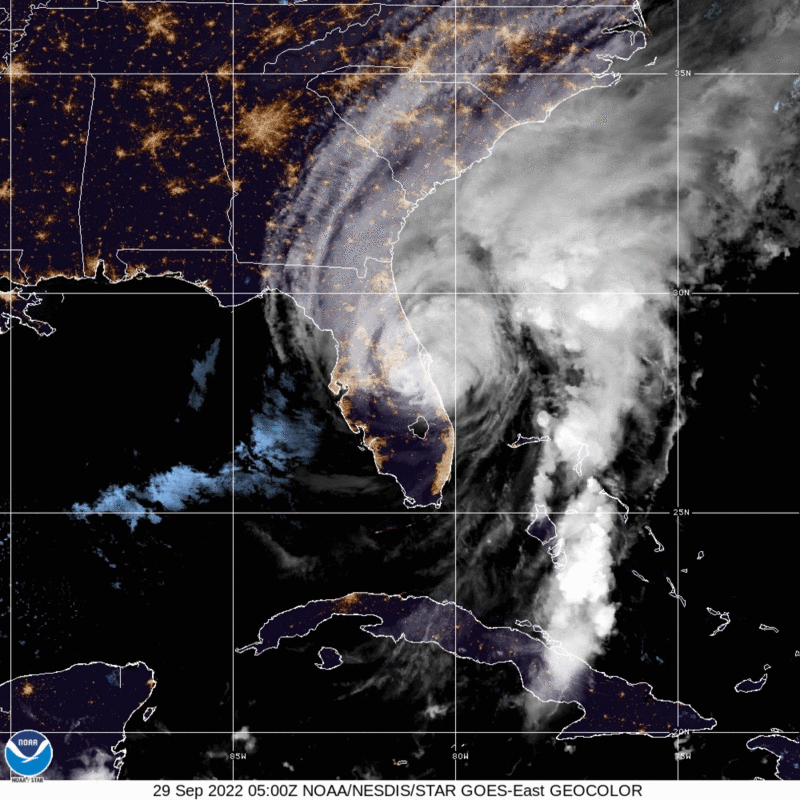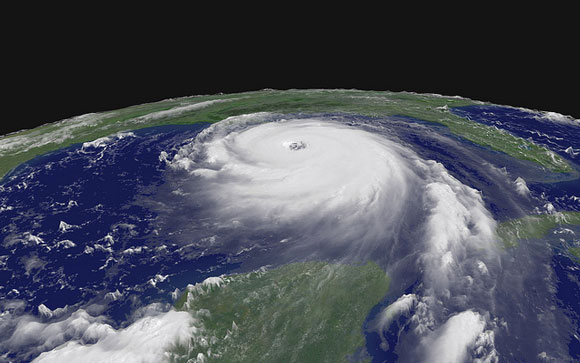
The 2023 Atlantic hurricane season officially starts June 1 and extends through November 30. On May 25, 2023, NOAA’s Climate Prediction Center released the hurricane season outlook for this year. They’re predicting a near normal season, with 12 to 17 named storms. They predict that five to nine of those will become hurricanes, and that there should be between one to four major hurricanes with winds 111 mph (179 kph) or higher.
La Niña vs. El Niño
We’ve had three La Niña years in a row. Then, this spring, forecasters saw a jump in sea surface temperatures. Warmer waters tend to favor hurricane formation. However, meteorologists predict that the core of the hurricane season, from August to October, will coincide with El Niño conditions.
According to Climate.gov:
El Niño favors stronger hurricane activity in the central and eastern Pacific basins, and suppresses it in the Atlantic basin. Conversely, La Niña suppresses hurricane activity in the central and eastern Pacific basins, and enhances it in the Atlantic basin.
So forecasters do not have comparable years for these types of warmer sea surface temperatures we’re now experiencing and El Niño conditions. And keep in mind that the outlook from NOAA is for overall seasonal activity, not a landfall forecast.
If you live near the Atlantic basin, you should keep up-to-date with forecasts from the National Hurricane Center.
Learn more about how to prepare for hurricane season.
Where do hurricane names come from?
Meteorologists long ago learned that naming tropical storms and hurricanes helps people remember the storms, communicate about them more effectively, and consequently stay safer if and when a particular storm strikes a coast.
These experts assign names to tropical storms according to an approved list before the start of each hurricane season. The U.S. National Hurricane Center started this practice in the early 1950s. Now, the World Meteorological Organization (WMO) generates and maintains the list of hurricane names.
Here are the hurricane names for 2023
Atlantic hurricane names (season runs from June 1 to November 30) are: Arlene, Bret, Cindy, Don, Emily, Franklin, Gert, Harold, Idalia, Jose, Katia, Lee, Margot, Nigel, Ophelia, Philippe, Rina, Sean, Tammy, Vince and Whitney.
Eastern North Pacific hurricane names (season runs from May 15 to November 30) are: Adrian, Beatriz, Calvin, Dora, Eugene, Fernanda, Greg, Hilary, Irwin, Jova, Kenneth, Lidia, Max, Norma, Otis, Pilar, Ramon, Selma, Todd, Veronica, Wiley, Xina, York and Zelda.
If you’re interested, you can view those names, and names for upcoming years, at the U.S. National Hurricane Center.

How and why did hurricanes first begin receiving names?
While people have been naming major storms for hundreds of years, most hurricanes originally had a designation using a system of latitude-longitude numbers. This was useful to meteorologists trying to track these storms. Unfortunately, this system confused people living on coasts seeking hurricane information.
In the early 1950s, the U.S. National Hurricane Center first developed a formal practice for storm naming for the Atlantic Ocean. At that time, storms got their names according to a phonetic alphabet (e.g., Able, Baker, Charlie) and the names used were the same for each hurricane season. In other words, the first hurricane of a season was always named “Able,” the second “Baker,” and so on.
In 1953, to avoid the repetitive use of names, the National Weather Service revised the system to give storms female names. By doing this, the National Weather Service was mimicking the habit of naval meteorologists, who named the storms after women, much as ships at sea traditionally had female names.
In 1978–1979, they revised the system again to include both female and male hurricane names.
See the complete history of naming hurricanes, including retired names, from NOAA.
When does a storm receive a name?
Tropical storms get a name when they display a rotating circulation pattern and wind speeds reach 39 miles per hour (63 kilometers per hour). A tropical storm develops into a hurricane when wind speeds go above 74 mph (119 kph).
Experts have developed lists of hurricane names for many of the major ocean basins around the world. Today, there are six lists of hurricane names in use for Atlantic Ocean and Eastern North Pacific storms. These lists rotate, one each year. So that means the list of this year’s hurricane names for each basin will come up again six years from now.
However, there’s an exception to this practice. The World Meteorological Organization retires the names of extremely damaging hurricanes for legal, cultural sensitivity and historical reasons. For example, they retired the name Katrina in 2005 following the devastating impact that Hurricane Katrina had on New Orleans. Last year, the World Meteorological Organization Hurricane Committee retired the names Fiona and Ian.

Bottom line: On May 25, 2023, NOAA released its Atlantic hurricane outlook for the upcoming season. Read more here and get the list of 2023’s hurricane names.
Read more: What is a hurricane storm surge?
The post 2023 Atlantic hurricane outlook and list of names first appeared on EarthSky.
from EarthSky https://ift.tt/0hmvV8j

The 2023 Atlantic hurricane season officially starts June 1 and extends through November 30. On May 25, 2023, NOAA’s Climate Prediction Center released the hurricane season outlook for this year. They’re predicting a near normal season, with 12 to 17 named storms. They predict that five to nine of those will become hurricanes, and that there should be between one to four major hurricanes with winds 111 mph (179 kph) or higher.
La Niña vs. El Niño
We’ve had three La Niña years in a row. Then, this spring, forecasters saw a jump in sea surface temperatures. Warmer waters tend to favor hurricane formation. However, meteorologists predict that the core of the hurricane season, from August to October, will coincide with El Niño conditions.
According to Climate.gov:
El Niño favors stronger hurricane activity in the central and eastern Pacific basins, and suppresses it in the Atlantic basin. Conversely, La Niña suppresses hurricane activity in the central and eastern Pacific basins, and enhances it in the Atlantic basin.
So forecasters do not have comparable years for these types of warmer sea surface temperatures we’re now experiencing and El Niño conditions. And keep in mind that the outlook from NOAA is for overall seasonal activity, not a landfall forecast.
If you live near the Atlantic basin, you should keep up-to-date with forecasts from the National Hurricane Center.
Learn more about how to prepare for hurricane season.
Where do hurricane names come from?
Meteorologists long ago learned that naming tropical storms and hurricanes helps people remember the storms, communicate about them more effectively, and consequently stay safer if and when a particular storm strikes a coast.
These experts assign names to tropical storms according to an approved list before the start of each hurricane season. The U.S. National Hurricane Center started this practice in the early 1950s. Now, the World Meteorological Organization (WMO) generates and maintains the list of hurricane names.
Here are the hurricane names for 2023
Atlantic hurricane names (season runs from June 1 to November 30) are: Arlene, Bret, Cindy, Don, Emily, Franklin, Gert, Harold, Idalia, Jose, Katia, Lee, Margot, Nigel, Ophelia, Philippe, Rina, Sean, Tammy, Vince and Whitney.
Eastern North Pacific hurricane names (season runs from May 15 to November 30) are: Adrian, Beatriz, Calvin, Dora, Eugene, Fernanda, Greg, Hilary, Irwin, Jova, Kenneth, Lidia, Max, Norma, Otis, Pilar, Ramon, Selma, Todd, Veronica, Wiley, Xina, York and Zelda.
If you’re interested, you can view those names, and names for upcoming years, at the U.S. National Hurricane Center.

How and why did hurricanes first begin receiving names?
While people have been naming major storms for hundreds of years, most hurricanes originally had a designation using a system of latitude-longitude numbers. This was useful to meteorologists trying to track these storms. Unfortunately, this system confused people living on coasts seeking hurricane information.
In the early 1950s, the U.S. National Hurricane Center first developed a formal practice for storm naming for the Atlantic Ocean. At that time, storms got their names according to a phonetic alphabet (e.g., Able, Baker, Charlie) and the names used were the same for each hurricane season. In other words, the first hurricane of a season was always named “Able,” the second “Baker,” and so on.
In 1953, to avoid the repetitive use of names, the National Weather Service revised the system to give storms female names. By doing this, the National Weather Service was mimicking the habit of naval meteorologists, who named the storms after women, much as ships at sea traditionally had female names.
In 1978–1979, they revised the system again to include both female and male hurricane names.
See the complete history of naming hurricanes, including retired names, from NOAA.
When does a storm receive a name?
Tropical storms get a name when they display a rotating circulation pattern and wind speeds reach 39 miles per hour (63 kilometers per hour). A tropical storm develops into a hurricane when wind speeds go above 74 mph (119 kph).
Experts have developed lists of hurricane names for many of the major ocean basins around the world. Today, there are six lists of hurricane names in use for Atlantic Ocean and Eastern North Pacific storms. These lists rotate, one each year. So that means the list of this year’s hurricane names for each basin will come up again six years from now.
However, there’s an exception to this practice. The World Meteorological Organization retires the names of extremely damaging hurricanes for legal, cultural sensitivity and historical reasons. For example, they retired the name Katrina in 2005 following the devastating impact that Hurricane Katrina had on New Orleans. Last year, the World Meteorological Organization Hurricane Committee retired the names Fiona and Ian.

Bottom line: On May 25, 2023, NOAA released its Atlantic hurricane outlook for the upcoming season. Read more here and get the list of 2023’s hurricane names.
Read more: What is a hurricane storm surge?
The post 2023 Atlantic hurricane outlook and list of names first appeared on EarthSky.
from EarthSky https://ift.tt/0hmvV8j

Aucun commentaire:
Enregistrer un commentaire